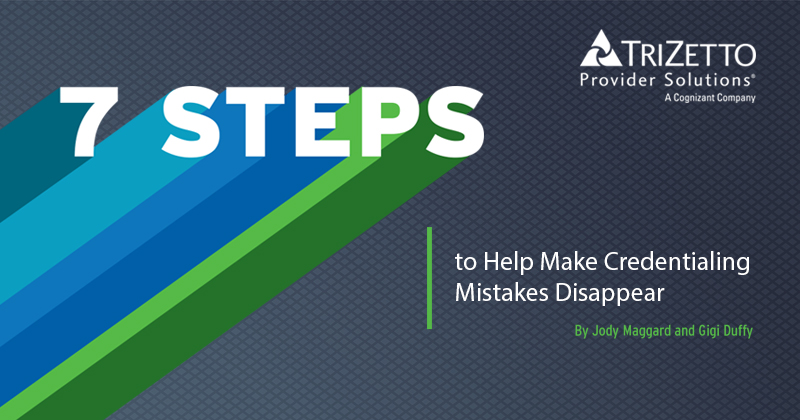7 Steps to Help Make Credentialing Mistakes Disappear

TriZetto Provider Solutions Shares Their Expertise
This is a sponsored and guest blog post by TriZetto Provider Solutions, A Cognizant Company. Learn more about TriZetto at MOMENTUM.
We all like to think we’re experts when it comes to topics such as car repairs, home improvements, computers and cooking—you name it. That’s why there are so many internet “fail” videos demonstrating the disastrous, often hilarious, outcomes of cooking catastrophes and home repairs gone awry, and it’s probably a video genre you prefer to not be featured in.
Take credentialing at a medical practice. While members of your highly-skilled team provide excellent patient care at your practice, who handles credentialing? While credentialing is fundamental to the ongoing success of the provider’s business, oftentimes it’s not a core strength.
Seven Steps Toward Credentialing Success
With that idea in mind and based on experience, we’ve listed seven basic steps to enroll a new provider with a payer. And actually, the process is generally the same for physician re-credentialing too. Based on this list, credentialing might seem like something an accomplished DIYer could complete in a few weeks. However, based on our years of experience, it’s often best left to an experienced team of professionals.
After a provider signs an employment contract with the practice, a number of important steps should be taken prior to the provider seeing and billing for patients. Here’s an abbreviated list.
Step 1: Practice receives documents from the new provider (valid medical license, DEA certificate, education and training records and board certifications).
Step 2: New provider submits documents to the payer.
Step 3: New provider packet for payer complete.
Step 4: Packet submitted to the payer.
Step 5: Follow up with the payer to confirm receipt of information.
Step 6: Payer reviews materials.
Step 7: New provider approved by the payer.
It’s easy to see how the credentialing process can go wrong quickly without careful attention. Each step should be monitored and double checked as practices can face potential issues when credentialing doesn’t go as planned. Issues that could arise include:
- Revenue loss;
- Retroactive billing;
- Claims denied;
- Payer drops provider; and
- Patient satisfaction decline.
Some Credentialing Best Practices Tips
Outlined below are some steps we have found beneficial for practices. To help the credentialing process go as planned, assign one person to take it through to completion.
- Create a checklist for requesting documents from the new provider;
- Check that the correct application is being used;
- Attach all required supporting documents; and
- Implement a tracking system to track when the practice sends information, is received by the payer and approved.
Finally, it can be helpful to set up a meeting with a few people in the office to review the entire application and compare it to the information requested by the payer. Partial applications are often sent to payers so having more than one person checking can be a good idea.
At this point, the practice’s part is complete, for the time being. Now it’s time to ship the package to the payer for approval.
Get It Done
In our experience, and other sources report the same, credentialing may take anywhere from 90 to 150 days once the payer receives the documentation. There are generally three issues that can push the process far past three months:
1. It’s imperative the credentialing process at the practice begins well in advance of the new provider’s first day at work. Practices that delay starting the process can take a hit to operations, patients may need to reschedule and patient satisfaction can plummet.
2. Physician re-credentialing uses a similar process that was used the first time. For re-credentialing, however, it’s necessary to confirm that collected documents remain accurate or are appropriately updated.
3. Many credentialing packets are incomplete when submitted to providers. An unfinished submission restarts the process when it’s nearly finished. “85 percent of applications are missing critical information,” according to a credentialing manager quoted in Physicians Practice. Typically, the missing information is basic but contains necessary detail about the new physician.
Help prevent getting a late start on the process and incomplete packets by utilizing a solution designed by credentialing experts who know and understand the intricacies of gathering the right information from providers for payers. Their responsibilities should include validating and tracking the information every step of the way, as well as delivering regular status updates. The ongoing follow-up process with the payer is essential to successful, first-time credentialing.
Credentialing, or credentialing done right, takes time, effort and likely more than the single “expert” working in the office. We suggest making your own successful video with our help. One that depicts how a well-thought-out and detailed credentialing process can allow the practice to help patients quickly, reduce administration costs, improve operations and allow the organization more time to focus on business strategy.
If you’d like to find out how TriZetto Provider Solutions can help your practice perform better, please contact us at [email protected] or 800.969.3666.




